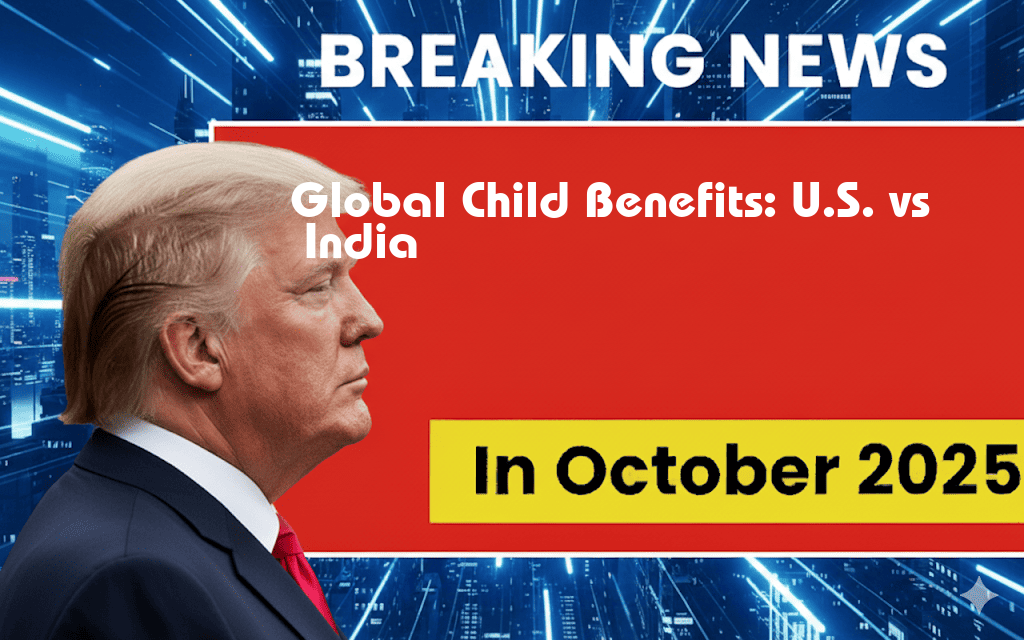The ongoing debate about child benefits around the world has gained renewed attention with stark contrasts between the United States and India. The U.S. offers a child tax credit of approximately $2,200 per child, aimed primarily at alleviating financial burdens for families, while India provides a substantial child benefit amounting to ₹1,65,000 (approximately $2,000) per child annually. This article examines the implications of these benefits, their effectiveness in combating poverty, and the broader economic contexts in which they operate.
Understanding Child Benefits in the U.S.
In the United States, the child tax credit has undergone significant changes in recent years, particularly during the COVID-19 pandemic. The American Rescue Plan temporarily increased the credit for 2021, allowing families to claim up to $3,600 for children under six and $3,000 for those aged six to 17. However, the standard credit has reverted to $2,200 in 2023.
Key Features of the U.S. Child Tax Credit
- Eligibility: The credit is available to families with children under 17, subject to income thresholds.
- Refundable: Depending on income, portions of the credit can be refunded, offering additional support for low-income families.
- Impact on Poverty: Studies indicate that the expanded credits significantly reduced child poverty rates during their implementation.
Child Benefits in India
India’s child benefit scheme reflects the country’s commitment to supporting families, especially in economically disadvantaged areas. The amount of ₹1,65,000 is part of a broader initiative aimed at enhancing child welfare, education, and healthcare services.
Features of India’s Child Benefit Program
- Universal Reach: The program aims to cover all children, providing essential financial support regardless of income levels.
- Investment in Welfare: Funds can be used for education, health, and nutrition, addressing multiple facets of child development.
- Program Goals: The initiative seeks to improve the overall quality of life and reduce infant mortality rates.
Comparative Analysis of Child Benefits
| Feature | United States | India |
|---|---|---|
| Annual Benefit Amount | $2,200 | ₹1,65,000 (approx. $2,000) |
| Eligibility | Children under 17, income-based | Universal, all children |
| Refundable | Yes, for low-income families | No, fixed benefit |
| Impact Focus | Primarily poverty alleviation | Welfare, education, and health |
Economic Context and Implications
The economic context in which these child benefit programs operate significantly influences their effectiveness. The United States has a mixed economy with high living costs, which means that while $2,200 provides some relief, it may not fully cover the expenses associated with raising a child in urban areas. Conversely, India, with its diverse economies ranging from urban to rural, aims to provide a more substantial benefit that addresses various needs, although the actual value can vary dramatically based on location.
Public Reception and Future Directions
Public reception of these benefits varies. In the U.S., there is ongoing debate about the sustainability and adequacy of the child tax credit, with many advocates calling for a permanent expansion. In India, while the child benefit program has generally received positive feedback, challenges remain in ensuring that funds are effectively utilized and reach the intended beneficiaries.
Conclusion
Comparing child benefits between the U.S. and India reveals significant differences in approach, eligibility, and financial support. As both countries navigate economic challenges, the effectiveness of these programs will be critical in shaping future policies aimed at improving the welfare of children and families.
For more information on child tax credits and their implications, you can visit Forbes or learn more about India’s welfare programs on Wikipedia.
Frequently Asked Questions
What is the amount of the child benefit credit in the U.S.?
The child benefit credit in the U.S. is $2,200 per eligible child, which aims to support families with their childcare expenses.
How does India’s child benefit compare to the U.S.?
In India, families can receive a child benefit of ₹1,65,000 per child, which is significantly higher when converted to U.S. dollars, reflecting different economic conditions and family support systems.
What factors contribute to the differences in child benefits between the U.S. and India?
Factors such as economic conditions, cost of living, and government policies play a crucial role in determining the amount of child benefits provided in each country.
Are there any eligibility requirements for these child benefits?
Yes, both the U.S. and India have specific eligibility criteria that families must meet to qualify for child benefits, including income thresholds and the number of dependent children.
How do these child benefits impact families in each country?
Child benefits in both the U.S. and India are designed to alleviate financial burdens, providing families with essential financial support for education, healthcare, and daily living costs.

Leave a Reply